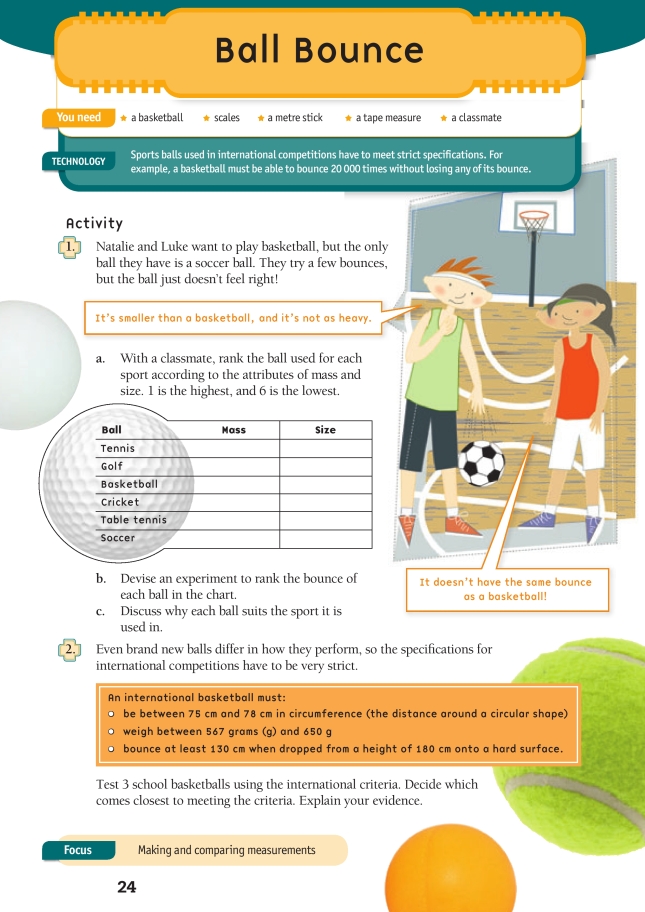This is a level 3 activity from the Figure It Out series.
A PDF of the student activity is included.
Click on the image to enlarge it. Click again to close. Download PDF (205 KB)
Sometimes objects are compared with each other, and at other times they are compared to an ideal standard. Standards are usually expressed in terms of minimum or maximum requirements and sometimes provide a range of acceptable values. The need for standards reflects the variability that exists in all objects, whether natural or man-made. The standard required for a basketball used in an international game will be much higher than the standard for a basketball used for an inter-school basketball game, which may in turn be higher than the standard required for a primary school PE lesson. This activity requires students to think about methods that they could use to gather data about bounce and provides an example of how such data is used in real life.
a tape measure
a metre stick
a basketball
scales
FIO, Technology Rules!, Levels 2+-3+, Ball Bounce, page 24
In this activity, students compare the mass, size, and bounce of sports balls. They devise a way to measure the bounce of a ball.
Factors to consider when devising an experiment:
- controlling as many variables as possible, for example, the height from which the ball is dropped and dropping the ball rather than pushing it
- making useful and accurate measurements
- repeating trials
- other aspects of bounce. For example, is the amount of time it takes for a ball to stop bouncing relevant?
The students can compare the size and mass of each ball without using formal measurements. Determining the relative bounce of each ball is more complex. Differences in the students’ rankings could lead to some interesting debates and will show how important it is to conduct a controlled experiment when comparing objects.
The students should incorporate more than one trial for each ball into their investigation to increase the validity of their experiment. There is likely to be variation in the results of each trial. Discuss reasons for this with the class.
The concept of variation is central to statistical thinking. Although variation can be found in all objects, the variability considered acceptable depends on the context in which the items are being used. Bouncing a ball 20 000 times to check whether it loses any of its bounce may be necessary for an international basketball. The school’s basketballs are unlikely to meet international basketball criteria. Discuss reasons for this with the class.
Measuring the bounce of a ball would be very difficult if you were working on your own. Working with a classmate or a group to conduct the investigation develops the key competency participating and contributing.
Technology-related student activities
- Investigate the idea of fitness for purpose. As a class, brainstorm the fitness for purpose of particular balls used out of context. For example, ask: How would a rugby ball perform in a game of football or netball? What would happen if you tried to play table tennis with a golf ball?
- Students research and discuss how technology may give an advantage to sportspeople. Ask Would modern athletes always beat those from an earlier time?
- The students could further investigate fitness for purpose and performance qualities by constructing an item with different materials. For example, they could build a model bridge of the same design out of straws, then paper, then wood, and then test the designs with weights.
Useful websites include:
www.techlink.org.nz/curriculum-support/papers/knowledge/tech-products/page2.htm
www.garrettsbridges.com
www.ballsout.com/info_balls.htm
http://soccerballworld.com/History.htm
www.livestrong.com/article/336471-the-history-of-rugby-balls
Exploring the technology-related context
Balls used for various sports are made from particular materials, which give the balls their performance properties. Often, there may be a variety of different balls for one particular sport. In golf, for instance, there is a large range (within a specified size). Different balls will fly further, take spin, or reduce the tendency to slice.
Any product is “fit for purpose” when its material and design provide the desired performance. People also have to take factors such as cost and safety into consideration when acquiring sporting goods.
Products have performance properties. This activity provides an opportunity to introduce vocabulary about performance attributes for specific products. For example, a rugby ball or a netball can be rated according to flight, bounce, grip, and durability.
Answers to activity
1. a. Likely rankings are shown in the table, although there may be some variation depending on the balls used.
| Ball | Mass | Size |
| Tennis | 4 | 4 |
| Golf | 5 | 5 |
| Basketball | 1 | 1 |
| Cricket | 3 | 3 |
| Table tennis | 6 | 6 |
| Soccer | 2 | 2 |
b. Practical investigation
c. Answers will vary. For a ball to travel a long distance, it needs to have mass. For example, a golf ball will travel much further than a table tennis ball. However, the size of a ball is also a factor. You would need a lot of external force to make a basketball travel as far as a golf ball.
When each ball is used in its sport, it is propelled rather than simply dropped, and this aspect is part of the design. For example, a basketball needs to bounce back more quickly than a soccer ball so that the basketball player can run while bouncing the ball. Balls that are hit with a piece of sports equipment are smaller than balls that are kicked or thrown.
2. Practical activity. Answers will vary.
